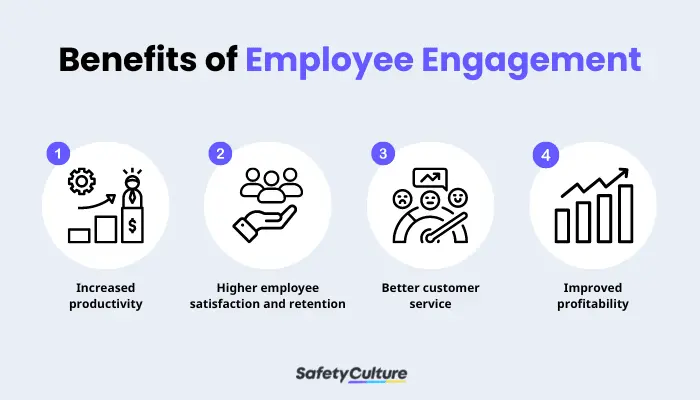What is Employee Engagement?
Employee engagement is the level of emotional connection, commitment, and involvement that an employee has towards their work and their organization. Engaged employees feel a sense of ownership and purpose in their roles, which leads to higher levels of productivity and job satisfaction.
Employee engagement may be influenced by various factors such as workplace culture, leadership, and job satisfaction, to name a few. Organizations that prioritize these factors can create a work environment that fosters engagement and motivation among employees.
Why is Employee Engagement Important?
Employee engagement is considered a critical factor in driving organizational growth and success. According to a study conducted by Gallup, only 36% of employees in the United States are actively engaged in their work, while there are only 20% of engaged employees around the world.
In human resource management, employee engagement is a key component as HR teams must put it at the forefront of their initiatives to help achieve the organization’s core goals. If HR teams conduct efforts in ensuring employees feel valued, they will work hard and go above and beyond to help the company succeed.

Benefits of Employee Engagement
Also, the following are just a few of the benefits of employee engagement when done right:
- Increased productivity: Engaged employees are more productive and efficient in their work. They are motivated to do their best and take pride in their accomplishments, which translates to higher-quality outputs and more favorable results.
- Higher employee satisfaction and retention: Engaged employees are more satisfied with their job and are less likely to leave their employers. This can then mean lower turnover rates, saving companies significant costs in hiring and training new employees.
- Better customer service: Engaged employees are more likely to provide exceptional customer service and go above and beyond to meet customer needs. As a result, there will be increased customer loyalty and positive word-of-mouth referrals.
- Improved profitability: Companies with high levels of employee engagement tend to be more profitable than those with low engagement levels. Engaged employees are more committed to the company’s success and are willing to put in extra effort to achieve it.
The Link Between Employee Engagement and Productivity
Another study conducted by Gallup found that companies with engaged employees had 21% higher profitability, fewer workplace injuries, decreased safety incidents, and higher productivity.
In relation to that, a study published in the Journal of Organizational Behavior found that employees who were more engaged had higher levels of job performance and were more committed to their organization.
Measuring Employee Engagement
There are several methods used to measure employee engagement, including the following:
- Surveys: Employee engagement surveys are a popular method for measuring employee engagement. Surveys provide quantitative data that can be easily analyzed and compared over time. They can be conducted online, via email, or in paper form. Also, they can include questions that measure employee motivation, commitment, and satisfaction. Another example is a work environment survey.
- Interviews: Interviews are a qualitative method for measuring employee engagement. One-on-one interviews allow the interviewer to ask follow-up questions and get a deeper understanding of the employee’s opinions and feelings. Interviews can be conducted in person, over the phone, or via video conferencing.
- Focus Groups: Focus groups are similar to interviews, but they involve a group of employees. Focus groups can be an effective way to identify common themes and issues that affect employee engagement. The group dynamic allows for the exploration of different perspectives and ideas.
Create Your Own Employee Engagement Survey Form
Eliminate manual tasks and streamline your operations.
Get started for FREEImportance of Combining Quantitative and Qualitative Data
While each method has its strengths, using a combination of quantitative and qualitative data provides a more comprehensive understanding of employee engagement. Quantitative data provides numerical measurements and comparisons, while qualitative data provides rich insights and perspectives.
Combining both data types allows for a more in-depth analysis of employee engagement. For example, a survey can reveal that 80% of employees are satisfied with their jobs, but an interview can provide insight into why the other 20% aren’t. By analyzing both types of data, organizations can identify the root causes of employee engagement issues and develop targeted solutions.
Improvement Strategies
Achieving a high level of employee engagement requires more than just paying competitive salaries and benefits. Here are some employee engagement strategies for improving programs in your organization:
Foster a positive work environment.
This can go a long way in boosting employee engagement. Provide a safe, comfortable, and attractive workplace that fosters teamwork and collaboration. Likewise, encourage an open-door policy, where employees can approach their supervisors and management to raise any concerns, ideas, or suggestions.
Provide clear communication.
Keep employees informed about company goals, strategies, and progress, and encourage them to share their thoughts and ideas. Make sure that communication is two-way, where employees can provide feedback, ask questions, and express their concerns.
Promote professional development.
Employees are more engaged when they have opportunities for growth and development. Provide training, mentorship, and training programs that can help them improve their skills and advance in their careers. Guide them in setting personal and professional goals and provide support and resources to help them achieve those goals.
Recognize and reward employee contributions.
Employees who feel valued and appreciated are more likely to be engaged in their work. Hence, have initiatives on recognizing and rewarding employees for their hard work. Continuously provide feedback and constructive criticism to help them improve their performance. You can also offer incentives, such as bonuses, promotions, or other perks, for outstanding results.
Encourage work-life balance.
Burnout and stress can quickly lead to disengagement. Some strategies to avoid this are providing flexible work schedules, telecommuting options, and vacation and sick leave benefits. In addition, make sure to promote wellness and mental health programs that are beneficial for employees’ stress management.
By investing in strategies to engage and motivate employees, organizations can create a culture of excellence and achieve their long-term goals.
Role of Leaders and Managers in Promoting It
Leaders and managers play a crucial role in promoting employee engagement and building a positive workplace culture. They set the tone for the organization, and their behaviors and actions have a significant impact on employee engagement levels.
They should communicate the organization’s vision and goals clearly and proactively involve employees in the decision-making process, whenever and wherever possible. Also, they must advocate for the development and growth of their employees, reward hard work, and ensure a psychologically safe working environment. Lastly, they should build and maintain an approachable image, be open to feedback from employees, and take action to address them.
FAQs About Employee Engagement
Organizations can consider these 3 C’s to create effective employee engagement programs:
- Career – growth opportunities, sense of purpose, high levels of enthusiasm at work
- Competence – learning and upskilling opportunities
- Care – purposeful leadership and management, empathetic approach
Knowing the various levels of employee engagement helps organizations understand where their efforts and programs are taking them and identify opportunities to improve them. The 4 most common levels are the following:
- Not engaged at all
- Barely engaged
- Moderately engaged
- Highly engaged
In every organization, the components incorporated into employee engagement efforts may slightly vary to fit its unique needs and goals. Though, those responsible for this initiative must ensure that the 4 key pillars are taken into consideration to ensure efficiency:
- Connection
- Meaning
- Impact
- Appreciation
Generally, organizations with higher levels of employee engagement have lower employee absenteeism rates. This is mainly due to the fact that since workers feel happier, more satisfied, and committed to their roles, there are lower chances that they’ll be flight risks, burnt out, and take more frequent leaves as a result of disengagement.




